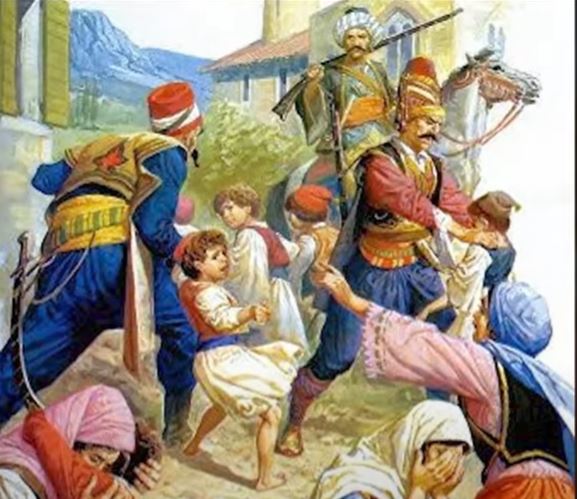By Harut Sassounian
Publisher, The California Courier
We all know that the Ottoman army invaded many countries with utter savagery. We also know that the Ottoman Empire committed mass killings and genocide against millions of Armenians, Assyrians, Greeks and Kurds. But, not everyone knows that the Ottoman Sultans routinely murdered their own family members.
Read also
I recently saw an incredible YouTube video that documented the barbaric behavior of the Ottoman Sultans. According to the 13-minute-long video, Ottoman leaders were engaged in “dark and messed-up practices.” The video is titled: “Creepy things that were ‘normal’ in the Ottoman Empire.” YouTube shows that the video was posted on October 15, 2021, and in less than six months, 640,975 people viewed the video of which 10,000 checked ‘like’. This means that over 640,000 people are now aware of the brutalities of the Ottoman Sultans.
Here is a partial transcript of the video:
“When [Sultan] Mehmed the Conqueror besieged Constantinople, his own uncle was fighting against him from the walls. In typical Ottoman fashion, Mehmed dealt with his uncle offering no mercy, and after he took the throne, he had a message for future generations of Ottomans. He began rounding up all of his male relatives and executed them. His ruthlessness didn’t even have an exception for his younger brother who was just an infant in the crib. Mehmet had him asphyxiated without batting an eye. Once Mehmet was done disposing all his possible competitors for the throne, he proclaimed: ‘Whomsoever of my sons the Sultanate shall pass, it is fitting that for the order of the world he shall kill his brothers. Most of the Ulema [high-ranking religious leaders] allow this. So let them act on this.’
“Thus began a series of generational civil wars where every next Sultan, successor of the Ottoman Empire, had to soak their hands in their own brothers’, cousins’, and uncles’ blood to secure the throne for themselves. It is said that another Mehmet, Mehmed III, was so heartbroken that he tore his beard off in agony as his younger brother begged for mercy and swore, again and again, to never raise a weapon against him. Yet, bound by the family traditions, Mehmed III turned away without speaking a word and the loyalists killed the young boy along with the rest of the 18 brothers of Mehmed III. Bodies of all 19 siblings were out on the streets of Istanbul and it is said that the whole city cried for the souls that night. Mind you, the murders would not just stop after the new Sultan would secure the throne. The hunt for all of the Royal family’s relatives would be carried on relentlessly.
“Even Suleiman the Magnificent’s hands weren’t clean as he had his son asphyxiated on the streets with a bowstring just because his popularity had become a matter of paranoia for the most acclaimed Sultan of the Ottomans. However, when Ahmed the First abruptly died in 1617, a general agreement was struck between the relatives and the family he left behind. Instead of drenching the streets of Istanbul with royal blood this time, the clergy quietly established the practice of primogeniture [the firstborn son’s right of succession] and announced his younger brother Mustafa the First as the new Sultan, because Ahmed’s sons were too young to rule. Mustafa himself was spared by his brother Ahmed the First as the 12-year-old and his 13-year-old brothers were too close to order death toward one another.
“Since then, the policy of killing relatives changed to incarcerating them. Potential heirs to the throne would be confined in the Topkapi Palace. In Istanbul, these special apartments would be referred to as the ‘kafes,’ however, in English this translates to the ‘cages.’ A prince of the Ottoman Empire would have to possibly spend his whole life imprisoned in the ‘kafes’ while being monitored day and night by guards. These princes were given all sorts of luxury and they were able to live a lavish lifestyle fit for royal kin, but the restrictions of house arrest were enforced strictly. This caused many of the princes to go mad from boredom or become heavily debauched. When a new Sultan would be taken to the [palace’s] Gate of Felicity to receive the allegiance of the viziers (Ministers), that very well would be the first time for him to be outside in decades! Not an ideal preparation for a man who is about to become the ruler, was it? And even though the ritualistic civil wars were put to an end, the royal relatives would still live their lives in constant fear of losing their heads at any second.”
The second half of the video describes the isolated life of the Sultan in his palace with his many concubines in the harem, overseen by the Sultan’s mother. We know that some of these women were young Armenian girls. The unnamed author of the video also described the beheadings in the palace and the two pillars on which the severed heads would hang.
From now on if anyone tells you that the Ottoman Empire was tolerant and civilized, you can send them a copy of this article or refer them to the above referenced YouTube video. That should shut them up.






















































